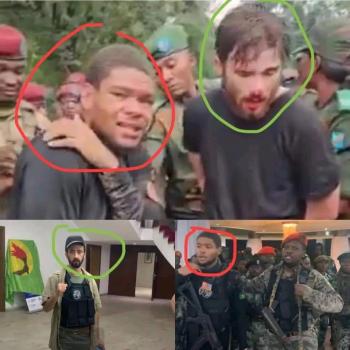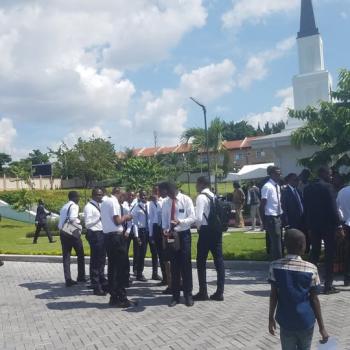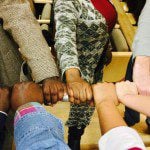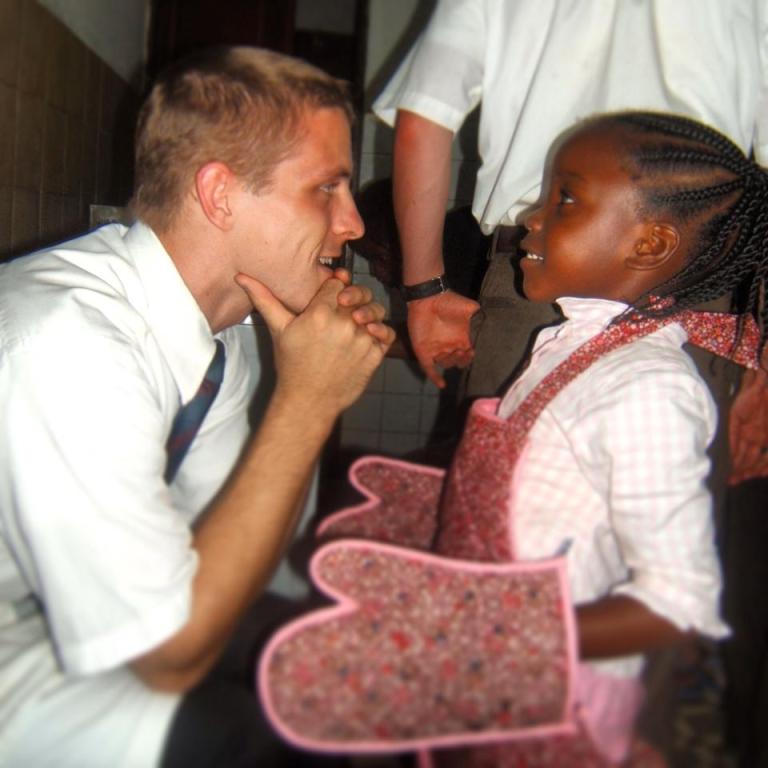The photo on the right was taken this morning. My brother, Dell, took it. That’s my dad and me in the swimming pool.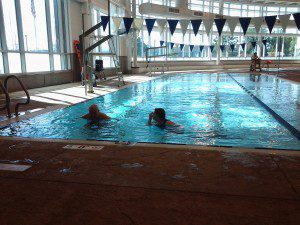
Yes, I still do aqua zumba, for those of you who love picturing that, and so does my husband. But lately, my brother has been taking Dad to swim before dialysis, and I often join them. In one week, Dad will turn eighty-three. In February, we will finish seven years of dialysis.
This morning, I walked alongside Dad as he swam. He broke his femur awhile ago, so he can’t really use one leg, but he still has a decent stroke. After he swam crawl (freestyle) nearly to the end of the pool, he said, “Let me see you swim, Margaret.” I did. Butterfly. I don’t think he has ever seen me do butterfly. He was grinning as I returned to his side. “Beautiful!” he said.
Blairs swim. All of us. One of my favorite stories is of my little brother Bobby, who was a champion swimmer. He once prepared for a race and glanced at his competition. The kid beside him said, “Doesn’t look bad. I think I can take this.” My brother said, “Yeah? Good.” Then the kid looked at him, his mouth suddenly dropping. “You’re Blair, aren’t you.” I wonder if Bobby smiled as he nodded. Probably. He won the race easily and “took State”. A decade later, as he was closing a stadium gate, it fell on him, pinning him to the ground at his pelvis. Thus began a new chapter of our lives, in which we visited Bobby at the hospital and then worked day by day towards his walking again. Dell took him swimming when Bobby was strong enough. He could do only small strokes. Bobby joked about it. “The accident was a great thing. I mean, Dell never gave me a bath until after the accident.”
Dell and I had our dad to ourselves during some our childhood. He drove us from Provo to Indiana, where he would pursue his graduate studies. The three of us went from state to state and from pool to pool as we drove. Swimming was a daily thing, and Dad swam with me on his back under water many times. Dell and I did underwater races. I don’t know if either of us could swim well at the time, but we knew how to thrust ourselves from one end of the pool to the other without breathing once. Mom and our three siblings flew to Indiana later. Eventually, there would be a total of eight Blairs. All swimmers.
Dell sits in Dad’s wheelchair as Dad swims. Sometimes, I guide Dad’s head so he won’t veer into the women playing water basketball. At the end of the session, Dell lowers the handicap chair into the pool, and Dad sits in it. This morning, it almost hit me as it lifted Dad to the side–where I was–and then up, up, to the hard world.
The following is something I wrote for “Mormon Scholars Testify” a couple of years ago, titled “Loving the Water”:
I am a swimmer. I am a swimmer because my mother needed to maintain her sanity, and so sent us kids off to the YMCA. There, we swam and Mom got a little break.
I was lousy at first, but they put me on the swim team thinking I’d learn by immersion (naturally). A meet was scheduled just a week after I became part of the team. Dad told me to not worry about winning, to just concentrate on form. “Don’t fight the water,” he said. I came in last, which was no surprise. I asked Dad how my form was. He told me it wasn’t quite “there,” but that it would get better.
Actually, my form was terrible. I was slapping and flapping, gasping and gulping. Dad was being kind by directing my thoughts to the hopeful future rather than my just-beginning, flailing attempts.
I did get better. I eventually got a trophy for “Most Improved Swimmer,” and went on to enjoy swimming long after my competitive days were over.
Five decades later, I love doing butterfly. My body simply knows what to do, and I periodically give tips to new swimmers trying to move forward with strokes which resemble butterfly, but propel them nowhere. What they don’t realize is that you have to make some underwater moves in order to go forward. If you simply observe someone doing butterfly, you won’t realize what’s happening in the depths you don’t see. And if you imitate only the above-water motions, you won’t get far.
So it is with my faith in the restored gospel of Jesus Christ. I was raised in the Church and learned the standard Mormon clichés and customary phrases of a Mormon testimony. As a child, I could imitate the strokes and expressions of Mormonism well, though of course mine was an immature, inexperienced faith, filled with songs about flowers nodding in a leafy garden. I was instructed in the basics, and was one of the children who re-learned “I Am a Child of God” after Spencer W. Kimball suggested that its author (Naomi Randall) revise it. She had initially written “Teach me all that I must know / To live with Him someday.” Elder Kimball suggested that she change “know” to “do.” So we Primary children re-learned the song.
That little revision continues to be significant to me. As I have grown in knowledge, it has mattered that my actions—my underwater motions, if you will—propelled me further into my faith. It has mattered that my initial baptism be renewed purposefully and often, that I not “fight the water” with doubt (including self-doubt), cynicism, anger, or shame, but learn to love immersion and to move beyond the shallow, messy places, and into the sweet depths.
As it has happened, I have also become immersed in a controversial area of LDS history: race issues and the priesthood restriction keeping those of African lineage from receiving the priesthood or temple blessings for over a century. I wrote three books and made two documentaries on these subjects with Darius Gray, a black man who joined the Church in 1964, fourteen years before the restriction was lifted.
I remember a day when I had been reading statements of past Church leaders regarding blacks. They were appalling, and I grew more and more disturbed. In the midst of my troubled thoughts, my phone rang. It was Darius. “Margaret,” he said, “I felt that I needed to call you. You’ve been reading some difficult material. I want to bear you my testimony. I can never deny what the Lord told me the night before my baptism.” (He had learned on that night that he would not be able to hold the priesthood, and had decided to not be baptized. Then he entered into prayer.) “I was told that this is the restored gospel, and I was to join. I hold on to that revelation. You need to hold on to it, too. Don’t let those statements grind you down.”
Thirteen years have passed since Darius and I began our work. We have experienced miracles—or rather, we have learned to recognize miracles. Almost weekly, we would receive letters, phone calls, visits by people who happened to have the exact information we needed. We became intimately acquainted with the good works done by black pioneers, and we met modern pioneers who were holding faithful despite overwhelming obstacles—including overt prejudice by their fellow Latter-day Saints. We were moved to new heights of faith, uplifted by those whose lives we studied, and by those we met. We recognized that we were not being led point by point on a straight trajectory, developing a compelling thesis, but from light to light, where we could see and understand more and more, and from a broader perspective than we would find in academia. We learned lessons of forgiveness and devotion which constantly outshone the sad lessons of our racist history. Perhaps most important, we learned to recognize the hand of God.
Likewise in my marriage, my husband and I have traveled the difficult terrain of disappointment and even depression as we’ve dealt with our children’s choices, which have sometimes challenged our faith in ourselves and in our parenting. But we travel together, keeping our form exact, trusting in the Lord and acknowledging His mercies—which sometimes reveal themselves as suddenly as a crocus in the snow.
My husband once gave me a priesthood blessing during a particularly trying moment. He said these words: “I bless you that your memories will be sanctified as the larger picture unfolds, and you will view all of the difficulties and trials you’re enduring now with gratitude and love.”
This is the blessing of perspective. It illuminates not only my personal history, but the hard historical episodes of my religion. I acknowledge the errors of men in my church’s past, but look upon them with the kind of mercy I hope myself to find from God. I love the fact that the Church of Jesus Christ of Latter-day Saints is a dynamic faith; that we believe in eternal progression and in continuing revelation. We believe in change, repentance, growth—as individuals, families, communities, and as a church. We are not condemned to the limits of past traditions; we are not cursed because of our lineages; we are not permanently tainted by our own sins or those of others. Jesus Christ—the master of the seas and calmer of tempests—provides a bridge to eternal betterment. His atonement is the core of my faith and the promise of my future.
I am now a seasoned Latter-day Saint, and have seen my oldest granddaughter baptized. I have learned to love the temple, where I serve as an ordinance worker. I have received revelation, peace, and comfort there. I have learned not just the hymns of my religion, but the truth behind them, which resonates in my soul with increasing power, inviting me to learn more of Christ and to receive His supernal, incomprehensible offering. I am well versed in the difficult chapters of our communal history, but awed by the journeys we as a people have made and continue to make. Though all of us flail at some points, growth is imprinted in our immortal DNA. We are to progress—walking, running, swimming, and sometimes flying in realms we occasionally realize are utterly glorious.



